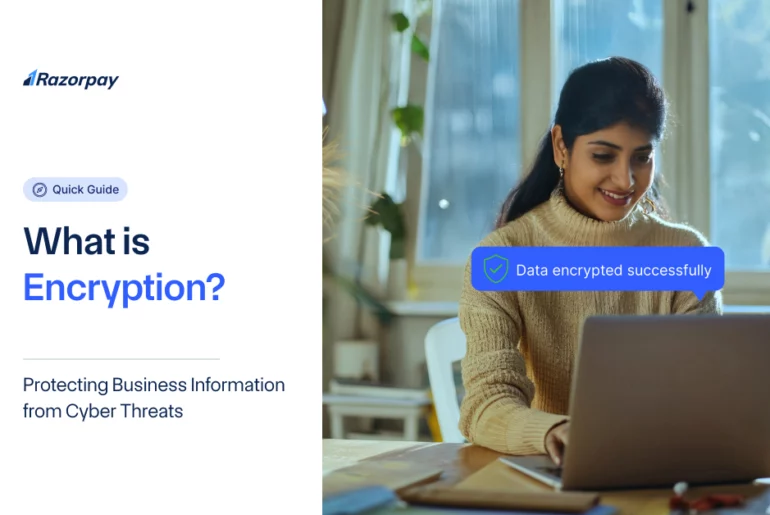Ever wondered how your online payments, messages, and personal data stay safe from hackers? That’s where encryption comes in. It’s like a secret code that scrambles your data, making it unreadable to anyone who isn’t supposed to see it. Whether you’re shopping online, using banking apps, or sending private messages, encryption works behind the scenes to keep your information secure. In this guide, we’ll break down what encryption is, how it works, its different types, and why it’s essential for data security — all in simple terms.
Table of Contents
What Is Encryption?
Encryption is the process of converting readable data into an unreadable format to protect it from unauthorised access. It ensures that only authorised parties can decode the information using a cryptographic key.
When you encrypt data, it transforms from plaintext (readable) into ciphertext (unreadable). This process uses an encryption algorithm and a cryptographic key—mathematical values shared between the sender and recipient—to secure the data.
How Does Encryption Work?
Encryption is a mathematical process that uses an encryption algorithm and a cryptographic key to transform readable data into an unreadable format. This ensures that only authorised users with the correct key can decrypt the information.
Imagine a Caesar cipher, a basic encryption method where each letter in a message is shifted by a specific number of places in the alphabet.
Here is a simple encryption example:
- Plaintext: “HELLO”
- Shift Key: 3
- Ciphertext: “KHOOR” (Each letter is shifted 3 places forward: H → K, E → H, L → O, and so on)
While the ciphertext appears random, anyone with the correct key (shift of 3 in this case) can easily decrypt it back into plaintext.
To prevent unauthorised access, modern encryption relies on complex keys, making it nearly impossible for third parties to crack the encryption. Data can be encrypted at rest (when stored) or in transit (while being transmitted) to protect it from cyber threats.
What Are the Different Types of Encryption?
1. Symmetric Encryption
Symmetric encryption uses a single key for both encryption and decryption. The sender encrypts the data using the key, and the receiver decrypts it using the same key. Since the same key is used at both ends, it must be shared securely to prevent unauthorised access. While symmetric encryption is fast and efficient, the challenge lies in securely distributing the key without interception.
2. Asymmetric Encryption
Asymmetric encryption uses a pair of keys—a public key for encryption and a private key for decryption. The public key can be shared openly, allowing anyone to encrypt data, but only the private key holder can decrypt it. This method enhances security as the private key remains confidential and never needs to be transmitted.
Asymmetric encryption is widely used in online security protocols like Transport Layer Security (TLS) and Secure Sockets Layer (SSL), which protect sensitive data in financial transactions and secure web communications.
Importance of Encryption
Encryption is essential for privacy, security, and data integrity, ensuring that sensitive information remains protected from unauthorised access.
It guarantees that only the intended recipient can access encrypted data, enhancing online payment security and safeguarding user privacy in transactions and communications. By preventing data breaches, encryption helps secure confidential information, even if a device is lost or stolen.
Encryption also ensures data integrity by preventing tampering or unauthorised modifications during transmission. Many industries and governments mandate encryption through regulations like the Health Insurance Portability and Accountability Act (HIPAA), Payment Card Industry Data Security Standard (PCI-DSS), and General Data Protection Regulation (GDPR) to enforce strict data protection standards and ensure compliance.
What Are Some Common Encryption Algorithms?
1. Symmetric Encryption Algorithms
Data Encryption Standard (DES):
Developed in the 1970s, DES was one of the earliest encryption standards. However, its 56-bit key is now considered weak against modern attacks.
Triple DES (3DES):
An improvement over DES, 3DES applies the encryption process three times for enhanced security. Despite this, it is gradually being phased out due to its slower performance.
Advanced Encryption Standard (AES):
AES is the most widely used encryption method today, offering 128-bit, 192-bit, and 256-bit key options. It provides strong security and is used in financial transactions and secure communications.
Twofish:
A successor to Blowfish, Twofish supports 128-bit block sizes and flexible key lengths, making it a secure choice for data encryption. Developed by computer security expert Bruce Schneier, Twofish allows key lengths of up to 256 bits and is known for its speed and efficiency.
2. Asymmetric Encryption Algorithms
RSA (Rivest-Shamir-Adleman):
Developed in 1977, RSA uses prime numbers to generate encryption keys. It remains one of the most trusted encryption methods, securing online transactions and digital signatures. It uses a pair of keys—one public and one private. The private key remains secure, while the public key can be shared freely.
Elliptic Curve Cryptography (ECC):
ECC provides the same level of security as RSA but with smaller key sizes, making it faster and more efficient. It is commonly used in mobile banking, SSL/TLS certificates, and secure messaging.
Each of these encryption methods plays a vital role in protecting sensitive data, securing financial transactions, and enabling digital signatures for authentication and fraud prevention.
Advantages of Encryption
1. Protects Data Across Devices and Networks
Encryption ensures that sensitive data remains secure, whether it is stored on a computer, mobile device, or cloud server. It also safeguards information while being transmitted over the internet, preventing hackers from intercepting or tampering with it. This is especially important for online banking, payment processing, and secure business communications.
2. Ensures Data Integrity and Prevents Alterations
Data encryption not only protects information from unauthorised access but also ensures that it remains unchanged during transmission or storage. If encrypted data is tampered with, it becomes unreadable or fails verification checks, alerting businesses to possible security threats. This is essential for maintaining the accuracy of financial records, legal documents, and confidential business information.
3. Helps Businesses Meet Compliance Requirements
Many industries must follow strict data security laws to protect customer and financial information. Regulations like HIPAA, PCI-DSS, GDPR, and FCPA require businesses to use encryption to prevent data breaches and avoid legal penalties.
4. Enables Secure Digital Transformation
As businesses increasingly rely on cloud computing, digital banking, and online services, encryption has become essential for securing customer data and financial transactions. It protects payment details during online purchases, prevents identity theft, and secures communications between businesses and customers.
Leading technology providers, including Google, offer advanced encryption services to protect cloud-stored data. These services include end-to-end encryption, key management solutions, and encrypted storage options, allowing businesses to safeguard sensitive information while maintaining operational efficiency.
Disadvantages of Encryption
1. Vulnerability to Ransomware Attacks
Cybercriminals exploit encryption to lock critical data and demand ransom for decryption. Without secure backups and strong cybersecurity measures, businesses risk permanent data loss. Organisations must adopt multi-layered security strategies to mitigate ransomware threats.
2. Key Management Challenges
Encryption keys must be stored and managed securely to prevent unauthorised access. If keys are lost or compromised, encrypted data becomes unreadable. Implementing automated key management systems ensures secure key generation, rotation, and retrieval.
3. Rising Threat of Quantum Computing
Quantum computers could break existing encryption, threatening financial transactions and secure communications. To stay ahead, businesses must adopt quantum-resistant encryption techniques that ensure long-term data security. Research into post-quantum cryptography (PQC) is critical for future-proofing encryption.
While encryption remains a crucial tool for data protection, it requires careful planning and management to minimise its disadvantages. By proactively addressing these risks, organisations can strengthen their cybersecurity posture while preparing for future advancements in technology.
Conclusion
Encryption is essential for protecting sensitive data, ensuring security, and meeting compliance requirements. It prevents unauthorised access, safeguards digital transactions, and maintains data integrity. With increasing cyber threats, businesses must prioritise encryption to secure financial transactions, customer data, and communications in the digital age.
Frequently Asked Questions (FAQs):
1. Why is encryption necessary for cybersecurity?
Encryption protects sensitive data from unauthorised access, cyberattacks, and payment fraud. It ensures that even if data is intercepted, it remains unreadable without the correct decryption key. This helps businesses safeguard financial transactions, personal data, and confidential communications.
2. How is encryption used in everyday technology?
Encryption secures online banking, messaging apps, cloud storage, and payment transactions. Technologies like SSL/TLS protect websites, while end-to-end encryption secures chats on platforms like WhatsApp. It ensures privacy and data protection in digital interactions.
3. Is encryption unbreakable?
No encryption is completely unbreakable, but breaking them would require immense computing power and time, making it impractical for most cyber criminals.
4. Can encrypted data be decrypted?
Yes, encrypted data can be decrypted using the correct decryption key or method. Without the key, decryption is nearly impossible, ensuring the data remains secure from unauthorised access.
5. How do I ensure the security of my encrypted data?
Use end-to-end encryption and enable it on all devices and services. Set strong passwords, update software regularly, and activate two-factor authentication (2FA). Turn on erase-data options to protect against theft or unauthorised access.
6. What are the legal implications of encryption?
Many industries must comply with data protection laws like GDPR, PCI-DSS, and HIPAA, which mandate encryption for securing sensitive data. In some countries, government agencies may require decryption access under certain laws.
7. What is end-to-end encryption, and why is it important?
End-to-end encryption ensures that only the sender and recipient can read a message. Even service providers cannot access the data, making it crucial for securing private conversations, financial transactions, and business communications.



